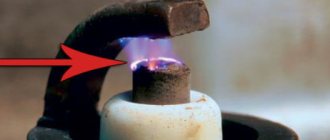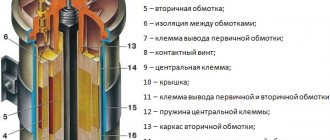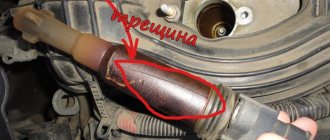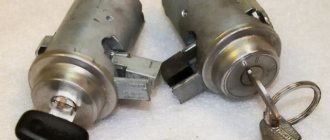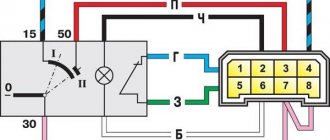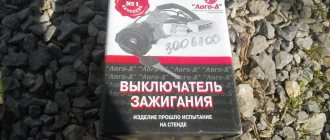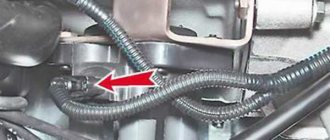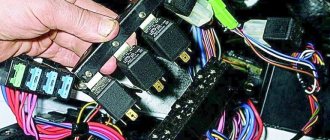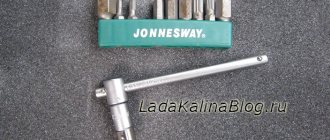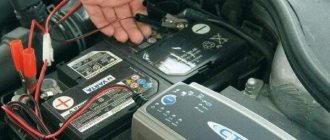January 28, 2016 Lada.Online 254 396 6
Often, owners of a VAZ 2121 or 2131 SUV encounter problems with starting the engine. For example, when you turn the ignition key, the starter does not turn. Let's look at possible problems with the Lada 4×4 starter and ways to solve them.
Silence when trying to start the engine
The Niva crankshaft cannot be turned by the starter.
There may be several reasons:
- Blown fuse.
- Poor contact between battery terminals.
- The battery is completely discharged.
- Failure of the starter solenoid relay.
- Failure of the intermediate relay that switches the starter circuit.
First of all, you should pay attention to the dashboard. When you turn on the ignition or the main electrical circuit in the engine, the lamps should light up on the dashboard or information should appear on the on-board computer, if we are talking about the Chevrolet Niva.
If this does not happen, the cause should be sought in the fuse box and in the battery contacts. During operation, oxides may form on these contacts, increasing the resistance. Loose contact connections can lead to sparking and burning.
If no blown fuses are found, you should check the reliability of the “+” contacts of the battery with the central wire and the “-” contacts with the vehicle ground.
To eliminate the malfunction, be sure to replace the fuses and clean the contacts. It would be a good idea to acquire even the cheapest tester in order to quickly check the presence of voltage in the electrical circuits of the car.
Where is the starter relay located?
The starter relay is located under the auxiliary fuse box next to the ignition relay. On the VAZ 21214, the starter activation relay is attached to the injection system relay bracket.
Clicking noises when trying to start the engine
If all contacts and fuses of the Niva are normal, you should turn the ignition key to the “start” position and listen to see if the relay clicks. If clicking sounds are heard clearly, the problem may lie in the starter voltage relay, the solenoid relay, or the starter coil circuit.
In “male” car services, the serviceability of the solenoid relay is usually checked by closing its contacts with a large screwdriver until the starter begins to rotate. For safety reasons, this should not be done under any circumstances.
If the problem is in the intermediate relay , then it is quite easy to replace it on the Niva. It is enough to insert the new relay block into the terminal block, observing the sequence and polarity of the connection.
To check the serviceability of the solenoid relay , the starter will have to be removed. After this, holding the starter, you should connect it to the battery and apply voltage to the contact of the solenoid relay. If a click is clearly heard, then the solenoid relay is working properly.
Also interesting: Create music with your own hands — — LiveJournal
Perhaps the cause of the malfunction is oxidized and burnt contact pads of the starter . To check them, you should disassemble the solenoid relay and clean the contact group. Sometimes the solenoid relay is non-separable and must be replaced along with the contact group.
If the solenoid relay works, but the starter rotor does not rotate, it is necessary to check the condition of its brushes, which may have worn out so much that they have lost contact with the winding. In this case, repairing the starter costs little money.
If the rotor is jammed or its winding is burned out, it is best to replace the starter assembly.
Chevrolet Niva does not start: three different sensors
The crankshaft position sensor will not indicate its failure in any way. The Check light will not light up, the engine will simply not start. Finding this sensor is easy if you know where the alternator belt is (see photo).
DPKV sensor connector
Here we check the serviceability of the wiring, as well as the distance from the sensor to the “teeth” (0.8-1.2 mm).
The second suspicious element will be the temperature sensor. The engine may not start only if it breaks. In this case, the electric fan should work without turning off. That is, a break in the DTOZH sensor circuit is easily recognized.
Element “6” is DTOZH
In the photo there is a sensor, and to get to it, the air duct is removed.
If the idle speed control malfunctions, the engine on a Chevrolet Niva does not start, but the starter turns. By the way, the Check lamp may be on. Diagnostics:
- Just lightly press the gas and turn on the starter;
- If the engine starts, but without gas it does not start, it means the IAC is faulty.
The starter rotor turns, but does not rotate the engine crankshaft
In some cases, the starter turns on, but instead of starting the Niva engine, a whistle or grinding noise is heard. Possible causes of the malfunction in this case are failure of the overrunning clutch mechanism (“Bendix”) or jamming of the retractor relay rod.
In the first case, it is necessary to replace or repair the overrunning clutch, and in the second, clean the retractor relay rod and lubricate it with grease recommended by the manufacturer. Any Litol type lubricant is suitable for this.
Video diagnosing the causes of an uncertain cold start
Along with high efficiency and relative reliability, fuel-injected cars have one unpleasant drawback - the difficulty of repair. It happens that the injector suddenly stops starting, and it becomes difficult to do anything with it. It’s good if you have the opportunity to call a tow truck or show the car to a professional, but what should those motorists do who are left with the problem alone? Let's figure it out by examining in detail all the reasons why the injector starts poorly or refuses to start at all, as well as how to “treat” such a malfunction.
The engine starts but soon stalls
The most common reason for this behavior of the Niva engine is the presence of any obstacle (air lock, clogged filter or failed fuel pump) in the path of fuel, or its complete absence. Look at the fuel level sensor. Perhaps you simply forgot to refuel your SUV, or the fuel left the tank against your will (it was leaked or drained by criminals).
In this case, be sure to check the integrity of the tank surface, all hoses and the filler neck shut-off device.
To check the serviceability of the fuel pump on gasoline carburetor engines, simply remove the hose from the carburetor inlet pipe and lower it into a previously prepared container.
After this, within 15-20 seconds you should crank the engine crankshaft with the starter, or pump up fuel manually. At the same time, a pulsating stream of fuel should appear from the hose. If this does not happen, the fuel filter must be replaced, and the fuel pump must be repaired or replaced.
In hot weather, when the car is left idle for a long time in the sun, another problem can occur: a vapor lock in the gas line. To remove it, you should use a regular tire pump, put its hose on the fuel supply fitting going to the gas tank and pump the pump several times. As a rule, this is quite enough to start the Niva engine.
In a Chevrolet Niva with electronic fuel injection, to determine the health of the fuel pump, you need to turn on the ignition and listen. When the electric pump is working properly, a quiet buzzing sound is always heard. If nothing happens when you turn on the ignition, and when you remove the hose, gasoline is not under pressure, you need to check the electrical circuit of the fuel pump, replacing the failed parts.
Also interesting: How to correctly perform chip tuning of a Niva engine
Another typical malfunction that causes the engine to stall is that the crankshaft position sensor (CPS) bracket is broken off. In this case, it is useful to check its fastening, as well as the condition of the wires and connectors.
Finding and solving immobilizer problems
Symptoms of problems with the immo system on a Chevrolet Niva are usually the following:
- The Check Engine indicator or immobilizer icon lights up on the instrument panel.
- The key installed in the lock does not allow starting the power unit of the car. The engine does not start and the crankshaft does not turn. Sometimes such problems can be regarded as a malfunction of the starter or battery.
The indicator on the dashboard can light up for various reasons, including if the light bulb itself is faulty.
Causes of malfunctions
The main causes of the problem:
- Discharge of the power supply in the blocker control key fob.
- Damage to the tag in the key. Because of this, the microprocessor control module cannot identify the car owner.
- Mechanical malfunctions - damage to the key itself or the control unit of the system. Contacts may oxidize or defects may appear on them. If the control unit is exposed to moisture, it may become flooded.
- Malfunction of the electrical component. This refers to the wires used to connect the blocker - they can be damaged.
- Software malfunctions of the control unit.
User Alexander Zakharov showed one of the signs of a malfunction in the operation of the Niva engine blocking device.
How to fix?
The procedure for troubleshooting and repairing a device that allows you to block the internal combustion engine with your own hands is as follows:
- The operation of the power source in the key is checked. If the battery is discharged, it must be replaced with a new one.
- If replacing the power source does not help, you need to check the integrity of the tag in the key. If it is damaged, you cannot fix it yourself. You will have to make a duplicate key.
- The immobilizer control unit is being diagnosed. Its integrity and contact elements are checked. If the latter are damaged or oxidized, they must be replaced or cleaned. In the case where the cause of the malfunction is the effect of moisture on the module, the only option to eliminate the problem may be to dry it. To do this, the module must be disassembled and the board itself must be placed in a warm and dry place.
- Problems with wiring can be diagnosed visually or using a tester. The last option is preferable because it is accurate. If visual diagnostics do not produce results, you need to ring all conductors with a multimeter to determine the damaged one. Broken cables, as well as wires with worn insulation, must be replaced.
- Software problems of the control module can only be resolved by flashing the device. It is very problematic to perform this task at home on your own; we recommend turning to specialists.
The starter turns the engine crankshaft, but the engine does not start
The widest range of Niva malfunctions, sometimes combined (several malfunctions at once that prevent the engine from starting and operating), is much more common than others. When describing such cases, we do not take into account engines with a faulty or unregulated gas distribution system, unregulated ignition and fuel supply system.
In frosty weather, the engine may not start due to insufficient battery charge. In this case, it is more advisable to remove it from the car, bring it to a warm room, thaw it, wipe it dry from condensation and charge it to the maximum voltage value.
If you urgently need to start the engine, you should unscrew the spark plugs, clean them of frost or condensation, then screw them back into place and try to start the engine again.
In some cases, you can use the emergency method . Boil water, remove the plastic casing and pour boiling water over the intake manifold. Then try to start again.
Under no circumstances should you start a cold Niva engine “from a pusher” or from a tow. There is a risk of serious damage to it.
Ignition system is faulty
Another main obstacle to starting a VAZ 2121 gasoline engine is the ignition system. Malfunctions in the heating system of a diesel engine can also make it significantly more difficult, and in cold weather, completely impossible to start it.
If a gasoline engine does not start, you should first check for high voltage on the center wire, or on the spark plugs with a separate ignition system without a distributor.
If the car has a contact (battery) ignition system, you should check the gap between the contacts, the condition of the cam, and also the capacitor. If the gap between the contacts does not correspond to the required value or the capacitor is shorted to ground, the reason has been found !
In other cases, you should definitely check the wires, distributor cap, and spark plug insulators for high voltage leaks. If there are black carbon tracks and cracks on the surface of these parts, they must be replaced.
ignition system is checked in a similar way . Particular attention should be paid to the spark plugs. There should be no traces of soot, soot, or oily deposits on the surface of their electrodes. Only the presence of a gray or brownish-red coating is allowed, which appears as a result of the combustion of various additives in gasoline.
You should also pay attention to the gaps between the central and side electrodes. Typically, the gap should not exceed 0.7 - 0.8 mm. Other parts, for example, quenching resistors and silicone wires should not have a resistance higher than 15 - 20 kOhm. When identifying the cause, also pay attention to the condition of all contacts, the presence of moisture and condensation.
Also interesting: Niva tuning: 145 photos of ideas on how to improve the VAZ 2121 with your own hands
The main difficulty when starting a diesel engine with a known good fuel supply system is faulty glow plugs. To check them, just turn on the voltage supply to them for 10-15 seconds, and then try to start the diesel engine. Glow plugs with a burnt-out spiral are quite difficult to distinguish from serviceable ones, so they must be identified by their electrical resistance. If the spark plug resistance is too low (1 - 5 ohms) or tends to infinity (several megaohms), the spark plug must be replaced.
The procedure for returning the car to “life”
Let's say you find yourself in circumstances where the injection engine starts poorly or refuses to do so at all. There is no need to hesitate in such a situation - it is advisable to immediately begin resuscitation procedures. If you don’t have time to figure out the exact reason why the car doesn’t start well, then you should quickly carry out the following algorithm of actions:
- First of all, we check the availability of gasoline and battery charge. Is there something missing? Fill it up and light it up. Let's try to start. If there is no result, proceed to the next step;
- Next, we quickly analyze under what circumstances the car malfunctions. If it takes a long time or is difficult to start when hot, we first check the spark plugs for overheating (light carbon deposits) and the functioning of the fuel system. Otherwise, when the car malfunctions both cold and hot, a more comprehensive approach is required. As a rule, the following procedures are sufficient: checking spark plugs, wiring the ignition system, assessing the operation of the injector and fuel system;
- Note that most motorists manage to solve the problem, so to speak, with little loss, that is, by implementing the actions described above. If you are not one of the lucky ones and your car still takes a long time, starts poorly or refuses to work at all, you will have to act globally. Here it is better to take the car to a service station or a convenient garage and check the compression, timing adjustment, clean the injector, assess the condition of the fuel system and ignition devices. If there are any malfunctions, they must, of course, be eliminated.
No fuel supply
Often the engine does not start if the fuel supply system . Attempts to start such an engine are usually accompanied by popping noises, shots in the muffler, the appearance of black smoky smoke and a strong smell of gasoline from the exhaust pipe. A malfunction in a carburetor engine is usually determined visually.
It is enough to shine a flashlight into the primary and secondary chambers. If there are traces of gasoline on the walls, and fuel does not spray out of the accelerator pump nozzle, but flows out in a thin stream, it is necessary to urgently identify and eliminate the malfunction. To accurately determine a malfunction in an injection engine, you need special equipment connected to the vehicle’s diagnostic connector, capable of reading error codes and faults .
To determine the serviceability of the injectors, you should disconnect them from the ramp, and then ask an assistant to crank the engine with the starter. If gasoline flows out of the injector nozzle in a thick stream or does not flow out at all, the injector should be washed in an ultrasonic bath or replaced.
To avoid various surprises along the way, it is recommended that you always check all engine systems before leaving, eliminating minor faults. For example, loose contact, friction of wires and hoses on various protrusions, leaks of oil and other liquids, etc.
In this case, you can not only eliminate minor breakdowns, but also identify and prevent more serious ones, which can lead to significant expenditure of effort and money. Always stay mobile. Good luck on the roads!
CARBURETTOR ICE
Of course, the engine may not start due to a malfunction of individual carburetor elements (contamination of jets, channels) or incorrect adjustment. If fuel does not flow, it is necessary to defect the fuel pump parts.
If you understand that fuel is being supplied to the intake manifold, but there is no ignition of the fuel-air mixture, you should “dig” in the following direction:
- Unscrew the spark plugs and evaluate the carbon deposits. If you are unable to start the engine right away, you may have already “flooded” the spark plugs. Now it is advisable to unscrew and dry them in any case;
- disconnect the main armor wire, bringing it closer to the metal part. Try turning the motor. You will immediately notice a spark if it comes to the ignition distributor. You should also check the armored wires for “breakdown”;
- If there is no spark on the main wire, carefully inspect the wires for breaks. If the circuit connections are in good condition, you should proceed to checking the coil. It is she who generates the spark;
- ignition distributor and its cover. Check the size of the gap, the cleanliness of the contacts, and the presence of play. Of course, if the ignition is not set correctly, the car will not start.
